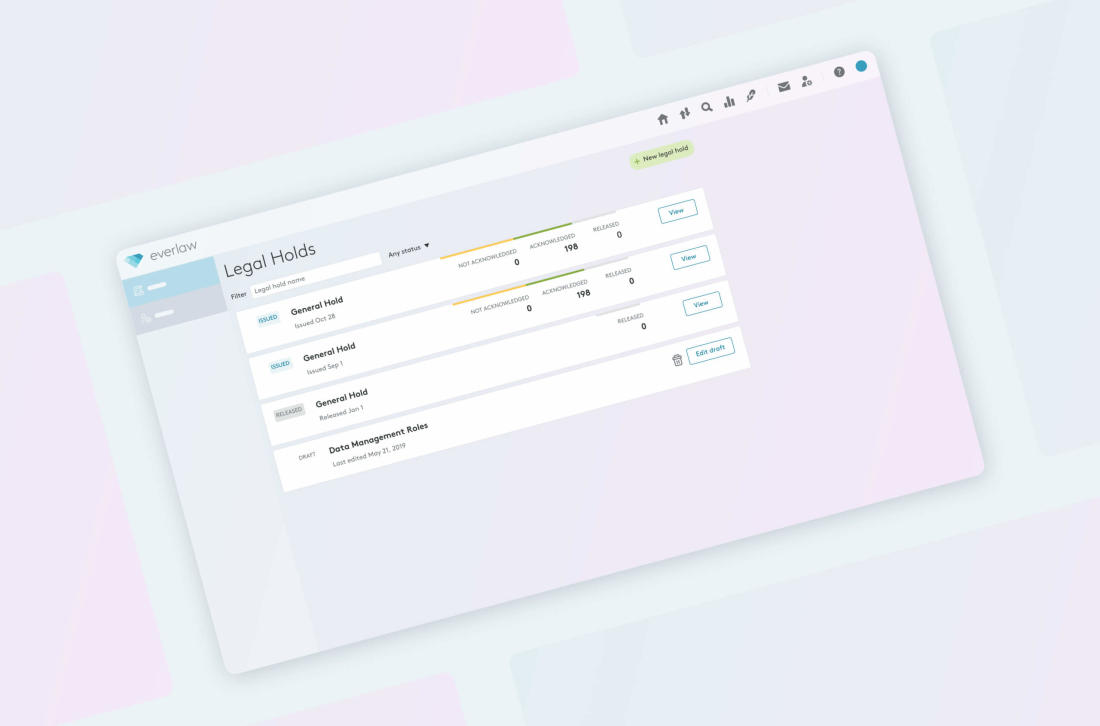What to Look for When Selecting Legal Holds Software
by Isabela Reid

Legal hold software enables legal professionals to make the process more efficient by automating tasks, such as issuing holds, sending out reminders and notifications, monitoring compliance, interviewing custodians, preserving relevant information, and tracking progress. However, it’s imperative that the solution chosen has specific capabilities that can accelerate the legal hold process without increasing risk and compromising defensibility.
Ensuring Your Legal Hold Software Is Equipped to Meet Your Needs
Here are a few of the capabilities that the right legal hold solutions should have:
Intuitive Legal Hold Creation and Deployment
Creating holds and sending them to relevant custodians doesn’t need to be difficult. When seeking out a new legal holds solution, it’s best to look for a solution with a user-friendly interface and that is simple to use — the fewer clicks, the better. Team members should be able to quickly access a detailed overview of all active holds, making edits or adding new custodians whenever necessary. Everlaw Legal Holds provides legal teams with an easy-to-use interface that allows for the creation and deployment of legal hold notices for up to hundreds of custodians.
Customizable Hold Notices
Customizable holds are a must, especially to increase custodian compliance. The solution should help users make the hold appear as if it’s being sent from the issuer’s email or leverage rich text formatting to emphasize certain words or phrases. This makes it easier for custodians to understand and acknowledge their obligation to preserve the relevant data.
Trackable Communication
Having an organized record of all information related to legal holds is crucial. Without the use of automation software, many legal teams find themselves in difficult positions when it comes to managing and tracking custodian acknowledgment. All communication (e.g., sending legal holds and custodians acknowledging the hold) should be tracked automatically. This will help reduce the risk of human error and eliminate wasted time.
Automated Notifications and Reminders
An incredible time-saver and risk mitigation tool, auto-notifications automate the process of nudging unresponsive custodians, allowing legal teams to focus on more productive tasks. Legal holds software should enable users to schedule notifications to fit a desired cadence so they don’t have to follow up manually. With Everlaw Legal Holds, this becomes a non-issue, and users no longer run the risk of having their entire holds process challenged for irregular or insufficient notification practices.
Automated Escalations to Managers
Auto-escalations to managers allow users to customize the cadence at which managers are alerted to a custodian’s failure to respond. By leaning on automation in this context, users always have an accessible record of their compliance efforts, establishing defensible audit trails that can be referenced should any custodian fail to comply after multiple attempts at re-notification.
Seamless Custodian Release Process
Removing a custodian should require as few manual tasks as possible. When custodians no longer need to be under a hold or the investigation/case has ended, the release process should take one — maybe two — clicks total. In essence, the process should be painless, straightforward, and timely.
Consolidated Legal Technology
It’s critical to find a single solution that can handle a user’s legal holds and ediscovery needs and avoid legal software fragmentation. By consolidating a legal tech stack, users can expedite their workflows while eliminating unnecessary costs and security risks. For example, Everlaw Legal Holds adds a new level of flexibility, putting an end to data distributed across multiple platforms and the potential security risks that come with using multiple software.
Enhancing the Legal Hold Process with Everlaw
We are proud to introduce Everlaw Legal Holds, the latest addition to our cutting-edge automation software for legal professionals. It integrates directly into the rest of the Everlaw platform, at zero additional cost to our customers and without any user limits.
With Everlaw Legal Holds, tracking notifications and custodian acknowledgment has never been easier. The same automation tools that have been proven to streamline everything from ediscovery to contract standardization can now be applied to transform your legal hold process. If you send a legal hold notice to a custodian at the onset of litigation, their collected data can be linked to the hold notice.

Final Thoughts on Legal Holds
Whether it relates to anticipated or active litigation, having strong management processes around legal holds is absolutely critical to a legal team’s ability to protect their organization. And because legal holds can be increasingly complicated and demanding, particularly in light of the complexity and volume of data most organizations manage today, it’s equally important that these processes be made as efficient and straightforward as possible.
But the unfortunate truth is that far too many legal teams continue to be bogged down by a reliance on traditional processes, whether it’s the constant maintenance of manually updated spreadsheets or the tedious engagement with hundreds of custodians through email. And what’s even worse is that these outdated practices not only waste your legal team’s valuable time and attention, but the human errors they produce also put your organization at significant risk of financial, legal, or reputational damage.
By leveraging the power of automated technology, managing legal holds becomes much more straightforward and far less stressful. With a platform like Everlaw, your legal team is one user-friendly integration away from a legal hold process that is more simple, secure, scalable, and defensible than ever before.
Check out “Streamlining the Legal Hold Process” to learn about the basics and challenges of legal holds, why they’re important, and more!

Isabela is a product marketer with experience in customer success. Isabela is a graduate of UC Berkeley and previously worked at the Human Rights Center at Berkeley Law.